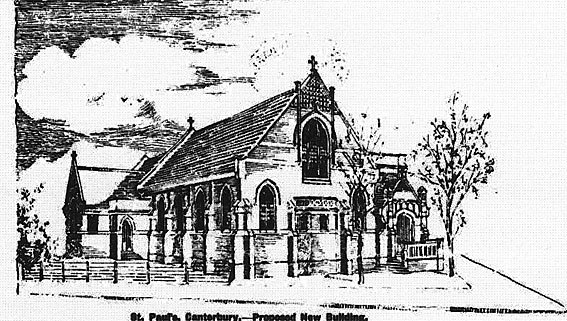
St Paul’s Anglican Church, Canterbury: Alfred Carleton’s initial design
[Camberwell and Hawthorn Advertiser, 28 February, 1914, p.2]
Historical and Technical Documentation by John Maidment
© OHTA, 2021 (last updated March 2021)

St Paul’s Anglican Church, Canterbury: Alfred Carleton’s initial design
[Camberwell and Hawthorn Advertiser, 28 February, 1914, p.2]
Historical and Technical Documentation by John Maidment
© OHTA, 2021 (last updated March 2021)
The first church at Canterbury was a wooden building dating from 1892 that was later moved to St Peter’s Church in Murrumbeena.1 The foundation stone of the present church was laid on 7 November 19142 and the building dedicated and opened on 11 April 1915. It cost £2600.3 The honorary architect was parishioner Alfred Ernest Henry Carleton FRVIA, a native of Dublin who arrived in Melbourne in 1887 and died in 1936.4 The builder was A. Holmes, of Malvern. The building was designed in Decorated Gothic style and built in red brick. The north porch, choir vestry and extended sanctuary date from 1931. The chancel has a granolithic mosaic floor. The original design envisaged a longer nave, but this was never completed and a porch erected in its place in 1953.5
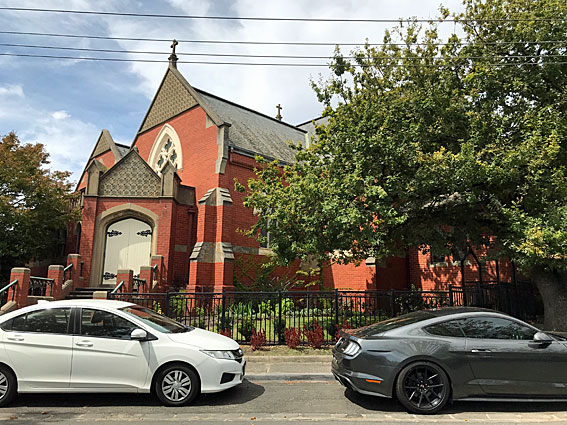
St Paul’s Anglican Church, Canterbury – exterior viewed from north-west
[photograph by John Maidment (7 March 2021)]

St Paul’s Anglican Church, Canterbury: interior from the rear
[photograph by John Maidment (7 March 2021)]
The building contains significant stained glass windows by Christian Waller (1932 and 1952),6 Brooks, Robinson (1934 and 1960), Mathieson & Gibson (1941), J.R. Ferguson & N. Papas (1969) and David Wright (2006).7 The Victorian Gothic reredos that came from the former wooden church has gilt panels painted by William Montgomery (1916), a locally unique surviving example of his work in this genre.8 The pews are of Tasmanian oak.

St Paul’s Anglican Church, Canterbury: organ before 1973
[St Paul’s Church Canterbury archives, courtesy of Jill Bales]
The organ, which cost £350, was built by Geo. Fincham & Son, of Richmond.9 In 1939 a new Swell Horn was ordered by Geo. Fincham & Sons Pty Ltd through Alfred Palmer & Sons at the request of the organist Leonard Fullard.10 At this time, provision was made for the addition of two further stops to the Swell, and Swell Octave and Sub Octave couplers were added.
The specification of the organ was recorded c.1950 by D.W. Rankin:
| GREAT Open Diapason Stop Diapason Clarabel Dulciana Principal Fifteenth Swell to Great SWELL Open Diapason Gedacht Viol d’Orchestre Voix Celeste Flute Horn Tremulant Swell Sub Octave Swell Super Octave PEDAL Bourdon Great to Pedal Swell to Pedal |
8 8 8 8 4 2 8 8 8 8 4 8 16 |
TC 1939 1939 1939 |
Tubular-pneumatic action
Attached stopkey console11
In 1959, Hill, Norman & Beard (Australia) Pty Ltd added a Gemshorn 4 and Flageolet 2 to the Swell on spare slides provided in 1939.12
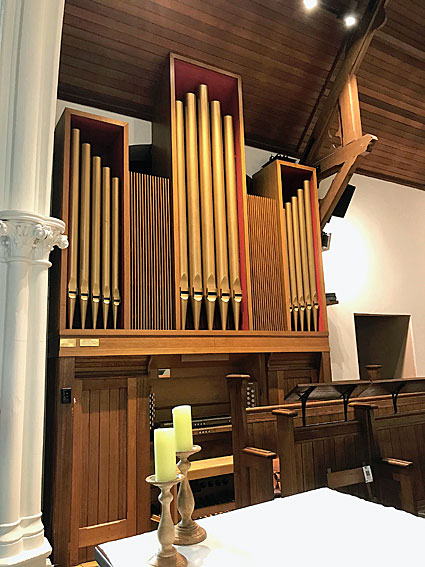
St Paul’s Anglican Church, Canterbury: the 1973 organ case
[photograph by John Maidment (7 March 2021)]
The instrument was rebuilt in 1965 by Hill, Norman & Beard (Australia) Pty Ltd to the designs of organist Ian J. Tyler ARCO in association with W.A.F. Brodie and C.M. Davies from the organbuilding firm.13 The work included conversion to electro-pneumatic action, a new oak attached drawstop console and many tonal changes and additions, some completed over the following years. New casework facing into the chancel was constructed in 1973.
| GREAT Principal Stopped Diapason Octave Flute Quint Super Octave Mixture 19.22.26 Zimbelstern Swell Sub Octave to Great Swell to Great Swell Octave to Great |
8 8 4 4 2-2/3 2 III |
A |
1965 former Clarabel 8 transposed placed on separate chest |
|
| SWELL Lieblich Gedeckt Salicional Voix Celeste Gemshorn Nazard Flageolet Tierce Dulcian Trumpet Tremulant Sub Octave Unison Off Octave |
8 8 8 4 2-2/3 2 1-3/5 16 8 |
TC 1959 former Flute 4 transposed 1959 TG 1965 placed on Open Diapason slide 1972 |
||
| PEDAL Principal Subbass Octave Flute Octave Mixture 12.15.19 Great to Pedal Swell to Pedal Swell to Pedal 4ft |
16 16 8 8 4 III |
B C B C B A |
1-12 1970 |
Gt & Ped Pistons Coupled
Swell to Pedal Pistons
Compass: 61/3014
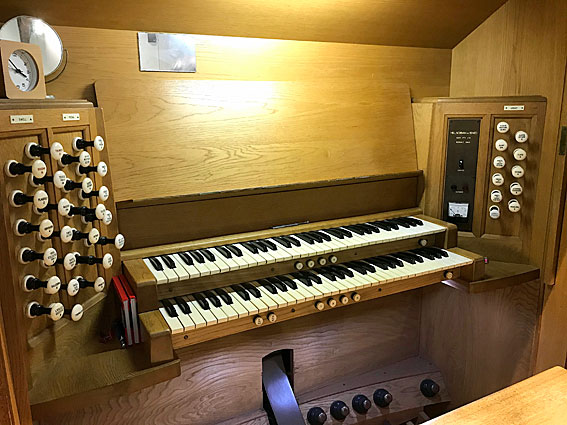
St Paul’s Anglican Church, Canterbury: the 1965 console
[photograph by John Maidment (7 March 2021)]
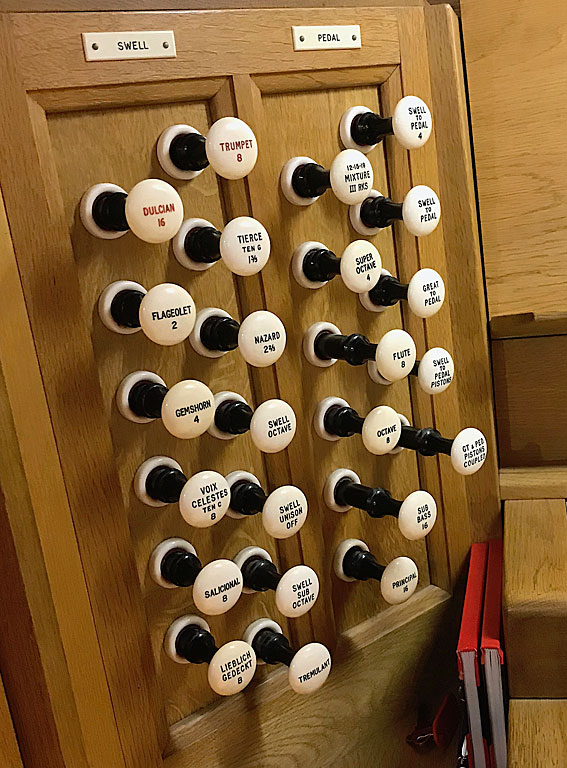
St Paul’s Anglican Church, Canterbury: the 1965 console – left jamb
[photograph by John Maidment (7 March 2021)]
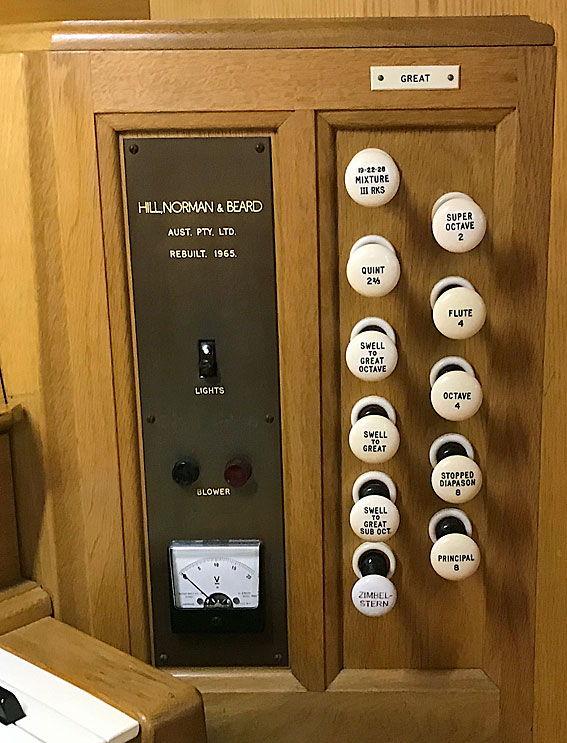
St Paul’s Anglican Church, Canterbury: the 1965 console – right jamb
[photograph by John Maidment (7 March 2021)]

St Paul’s Anglican Church, Canterbury: the altar and reredos with panels by William Montgomery and the rose window by Christian Waller
[photograph by John Maidment (7 March 2021)]
1 https://www.stpaulscanterbury.org.au/history accessed 16 March 2021
2 The Argus, 9 November 1914, p.6
3 Camberwell and Hawthorn Advertiser, 17 April 1915, p.7
4 The Age, 21 February 1936, p.11
5 https://www.stpaulscanterbury.org.au/history accessed 16 March 2021
6 National Trust of Australia (Victoria) citation: file number B7326
7 Information from the pamphlet Welcome to St Paul’s Anglican Church Canterbury: a tour guide
8 National Trust of Australia (Victoria) citation: file number B7326
9 Geo. Fincham & Sons Pty Ltd: list of organs
10 Letter from Geo.Fincham & Sons to Leonard Fullard 14 July 1939 (Fincham latter books, State Library of Victoria)
11 Specification provided to John Maidment 1970s
12 Hill, Norman & Beard order number V470
13 Hill, Norman & Beard order number V621; opening recital programme 24 October 1965. William Auld Fergusson Brodie FISOB (1895-1965) was managing-director of the firm 1937-1963 and the recital was dedicated to his memory.
14 Specification noted from 1965 pamphlet and checked by John Maidment 7 March 2021